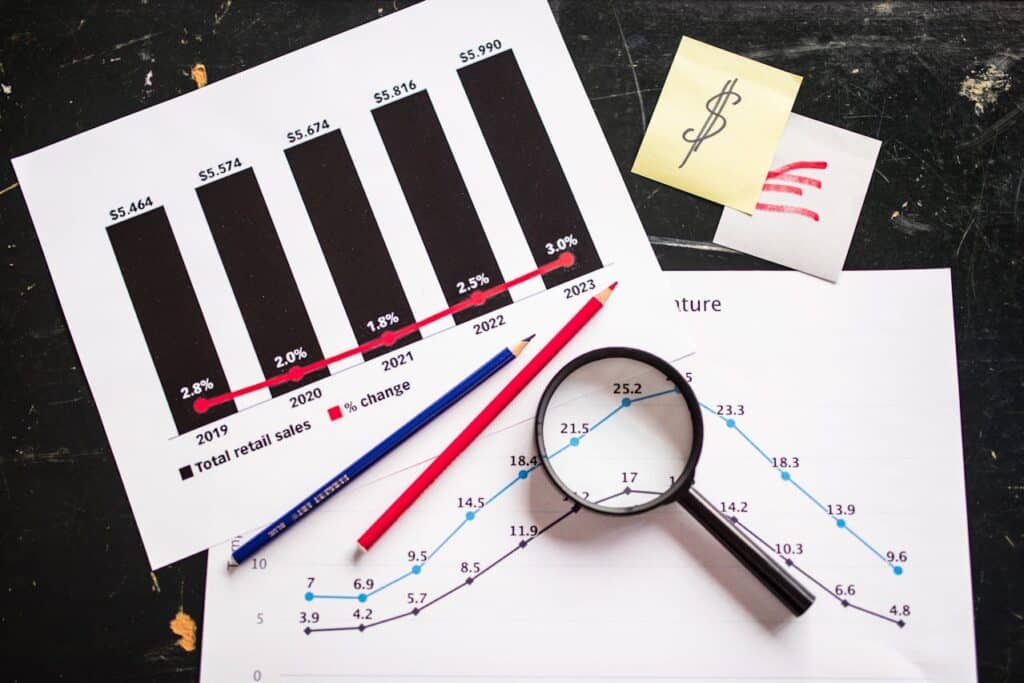How to Budget When You’re Broke: A Plan That Finally Works
For the weeks that feel rough when money is tight, here’s how you can budget when you’re broke so that you can stabilize the essentials, lower your stress, and make steady progress into the right direction.

Everything I share is backed by credible research, verified sources, and or my own personal experiences. Im not a therapist or financial advisor. I’m someone who’s lived through both sides of poverty and recovery. Compound Choices is made to work alongside therapists & financial advisers, not to replace them.
If you want one calm place to start on a week when cash is thin, you’re in the right spot.
Let’s walk through budgeting on a low income, setting up a tiny emergency fund when you’re broke, and using simple habits to reduce money stress so you can breathe and move forward.
Your card just got declined at the grocery store, rent is due Friday, and a renewal hit your account this morning. If that’s your week, this guide on how to budget when you’re broke will slow things down and help you pick the next right move.
We’ll list what’s due today, match it to your paydays, and carve out a few dollars for a starter cushion so the next surprise hurts less.
Let’s begin!
Get Through This Week First
What’s Due Today vs. Safe to Delay
If you’re budgeting on a low income, start by listing every bill that can actually cause a loss of housing, power, water, phone, or the ability to work. Those are your protect-first items. Next to each bill, write the real consequence of missing it and how fast that consequence happens.
Some bills have grace periods or hardship programs that buy time. Housing, utilities, basic phone or internet for work, and transportation come first. Use a short-term plan for everything else.
The Consumer Financial Protection Bureau has a simple worksheet that helps you weigh consequences and set priorities when you can’t pay everything at once.
It’s a quick gut check that keeps this week manageable. If you can, set aside a few dollars for an emergency fund when you’re broke so the next surprise does less damage.

If a renewal hit your account this morning, put it on the list, but also note whether you can cancel, prorate, or get a refund. Many services will reverse a renewal within a short window if you ask and explain that it will cause a hardship this week for you.
Keep this entire list visible. You’re not trying to solve the whole month right now. You’re trying to get through the next few days with the least damage, and that’s what we want!
Map Bills to Paydays
While budgeting on a low income, grab a calendar and mark your next deposit dates. Then draw arrows from each must-pay bill to the deposit that will fund it. If two must-pays land on the same paycheck, move one if you can, or split it across checks.
The goal is alignment. When bills and paydays line up, late fees and panic drop. If a bill routinely falls a few days before your deposit, call the company and ask to move the due date. This mapping strategy helps reduce money stress because you can see what gets paid and when.
There is a CFPB step-by-step worksheet that shows you how to analyze your schedule and request a due-date change.
Starter Cushion: $50 or $100 Micro-Fund
When money is thin, a tiny cushion can stop the next overdraft or bus pass emergency. Aim for the smallest target that still matters, like $50 or $100. Park it where you don’t see it every hour.
If you can, keep it in a separate savings pocket. If not, use a labeled envelope and store it out of reach. You’re not trying to build a full emergency reserve today. You’re building your first shock absorber, which is your emergency fund when you’re broke.
For context, Bankrate’s 2025 survey found only about two in five U.S. adults would cover a $1,000 surprise from savings, which means you’re not behind the pack if you are starting small.
All the more reason it’s so important budgeting on a low income. A small buffer is a win!
Fee-Waiver Calls That Work
If an overdraft, returned payment, or late fee hit, make the call the same day. Be direct, polite, and specific: “I had one unexpected charge today. I have not had a fee in the past six months. Can you remove it as a courtesy while I stabilize this week?”
Many banks have updated overdraft practices and disclosures, and you can also choose to opt out of overdraft on debit card transactions to avoid certain fees on one-time card purchases.
Taking this step helps reduce money stress and keeps your account steadier for the week. The CFPB explains your right to opt in or out for these transactions. Ask the bank to confirm your current status and how to change it.

Budget That Actually Fits a Small Paycheck
Survival Split for Low Income
When you’re budgeting on a low income, overcomplicated budgets fall apart. Try a simple split first that keeps you functional. One workable example is 70 percent for essentials, 20 percent for variable needs and a mini-cushion, and 10 percent for debt minimums until the crisis passes.
If your rent or childcare takes more, shift the percentages and keep the categories. The point is a small structure you can run on a single page. You can change the numbers next month without rebuilding the whole system.
Four Non-Negotiables
If you’re budgeting on a low income, protect roof, utilities, food, and getting to work or school first and foremost. That sequence minimizes the worst outcomes and preserves your ability to earn.
If utilities are at risk, call before the due date. Ask about payment plans, due-date changes, or hardship programs. Community navigators at 211 can connect you to local utility assistance, food programs, and housing support in minutes.
A quick call could reduce money stress by uncovering help you didn’t know existed.
One-Page Template You Can Do in 10 Minutes
Write your take-home at the top, list the four non-negotiables with targets, add a small buffer, and include a “hold” line for likely charges.
Keep categories broad and update this one-page control panel each payday. This is how to budget when you’re broke in practice, and the clarity helps reduce money stress.
Payday Alignment: Stop the Mid-Month Squeeze
Weekly/Biweekly Flow Setup
As soon as money lands, move essentials first. You can divide the month into two or four cycles and repeat the same steps each time: fund rent set-aside, cover utilities and transport, refill the starter cushion, then allocate for groceries and other needs.
Consistency is what stops the squeeze. If you work different hours, set a minimum baseline and treat anything above it as a bonus that goes to the cushion or catching up on a priority bill.
Bill-Date Moves That Help
If your key bills are out of sync, ask issuers to migrate them to dates that follow your paydays. Many credit card and utility providers let you change due dates and set alerts.
Use the CFPB due-date planning worksheet to map your bills and pick realistic dates before you call. A five-minute call today can save hours of juggling next month.

Cash Buffer Rules
Give your buffer a job. Keep a fixed small amount in your checking account that you try to never spend, and treat it as the floor under your account. If your balance dips below that floor, pause variable spending until you refill it.
This rule supports budgeting on a low income and helps reduce money stress by stopping one surprise from turning into a string of overdrafts.
Tiny Emergency Fund Playbook (From $25 to $250)
Quick Wins in 24–48 Hours
Look for dollars you can get back quickly. Return an unopened item, pause or cancel a subscription before the next billing, redeem any store credits, or check for any refunds you forgot about.
You can even sell items locally. If you received a bank fee, ask for a courtesy reversal and send that refund straight to the cushion. Repeat for small wins that add up slowly in time. A handful of tiny deposits beats a single perfect plan you never start.
Where to Keep It (So You Don’t Spend It)
If you keep the cushion at a bank or credit union, make sure the institution is insured and reputable. You can look up FDIC-insured banks with the BankFind tool.
A separate pocket or savings sub-account works best because it creates a small speed bump before you spend.
You can put spare cash in envelops, and keep the emergency envelope out of your daily reach. Try to not mix it with grocery cash. The barrier is the feature.
Refill Targets for the Next 30 Days
Pick achievable milestones. Aim for $100, then $250, then one week of essentials. Once you reach $250, set an auto-transfer of a very small amount per payday.
If your income in irregular, use a rule like “keep 2 percent of any deposit” so you grow the cushion without thinking about it. Then, as time goes on, increase that percent slowly for maximum savings.
Cut Costs Fast Without Feeling Deprived
Five-Ingredient Groceries + Zero-Waste List
Build a small list that covers breakfasts, a couple dinners, and snacks. Think eggs, oats or rice, beans or lentils, frozen vegetables, and a simple protein that cooks in one pan.
Keep a zero-waste list on your fridge for leftovers and items expiring soon. When you’re tired, grab from that list first. It reduces last-minute takeout and saves more of your money in a single week.

Transport for Less This Week
Check whether your city offers weekly transit passes that cap your spending, or employer commuter benefits that lower costs. If you drive, plan your routes in batches to reduce trips.
Ask one friend about carpooling for a short stretch. The point is not a perfect system. It’s one or two changes that cut costs without adding stress.
Subscription and App Audit
Open your bank app and scan the last 60 to 90 days for small, repeating charges. Those are the ones that slip by. Cancel the lowest-value items first and set a calendar reminder to check again next month.
If a renewal just hit, ask the provider to reverse it. Many will if you haven’t used the service since renewal.
Talk to People You Owe (And What to Say)
Payment Priority When You Can’t Pay All
Protect essentials first, then negotiate on the rest. If you need help deciding what to pay and when, use the CFPB’s prioritizing bills tool.
Their tool walks you through how to think about consequences and which payments are most urgent.
This keeps you focused on preventing the worst outcomes while you stabilize, which is most important.
Hardship Plans, Forbearance, and Minimums
When cash is short, call your creditors and ask about hardship options. Explain what changed, what you can pay this month, and when you expect things to improve.
Consider asking to move your due date, to set up a short-term payment plan, or to temporarily lower the minimum. Take notes on names, dates, and promises.
Confirm changes in writing if possible or email. Many companies will meet you halfway if you contact them before you miss a payment.
If Collectors Call
You have rights. Debt collectors must give you key information about the debt and provide validation on request. If you do not recognize a debt or the amount looks wrong, ask for written validation and pause payment decisions until you receive it.
The CFPB explains what collectors must provide. The FTC details how to dispute and asks you to send the letter within 30 days, ideally by certified mail, so they must stop collecting until they verify.
Keep copies of everything you send, as well as any conversations.
Reduce Money Stress Right Now
Ten-Minute “Breathe-and-List”
Stress makes decisions worse. Give yourself ten minutes. Sit, set a timer, breathe slowly, then write three lines: what is due today, who you need to contact, and your next small action. Then act on the first line and stop.
You’re building momentum, not perfection. If you have a friend who is good with money, text them your list. A quick reality check can help you act without spiraling.
Panic-Proof Bill Calendar
Use a simple month view. Color code the bills you need to pay and the ones you can move. Put paydays in bold. Add two alerts for each bill: one a week before, one two days before. Check off items as you pay them.
This creates a sense of progress that cuts stress.
How Money Stress Affects Mental Health
Money problems can drive anxiety, sleeplessness, and trouble concentrating. The APA’s Stress in America research shows finances consistently rank among top stressors for adults.
Recent polling also found grocery prices are a major source of stress for many households, which shows how daily costs can wear people down even when they do most things right.
When you’re budgeting on a low income, that pressure can rise faster. If stress feels unmanageable, reach out to a professional or a trusted support line. You’re not alone.

Income That Lands Fast (No False Promises)
Shift Swaps, Overtime, and One-Off Gigs
List what your employer allows first. Shift swaps or overtime often pay faster than any side job. If you freelance, reach out to a past client for one small task that you can deliver in 24 to 72 hours. Ask for half up front and the rest on delivery.
Avoid offers that require upfront fees or unclear promises.
Negotiating a One-Month Break
If rent is the issue, ask your landlord about a written payment plan. If childcare or utilities are the bottleneck, ask about short-term reductions, flexible dates, or fee waivers.
Document any agreement. You’re asking for temporary help.
Community Help That’s Actually Useful
Visit or Call 211 and explain your situation. The specialists are trained to match people to local programs for food, utilities, and housing.
Many callers discover resources they didn’t know existed. It’s confidential and available in most places.
Stop the Bleed: Overdrafts, NSFs, and Interest
Bank Settings That Save You Fees
Turn on low-balance and large-transaction alerts. Check whether you’re opted into debit-card overdraft for one-time purchases. If you are, you can choose to opt out, which means those transactions will usually decline rather than trigger a fee.
The CFPB’s guidance explains these rights and the opt-in rules under Regulation E. There has also been movement to reduce or limit overdraft fees, which means asking for a waiver today that can work better for you than it did a few years ago.
High-APR Traps to Avoid
Payday loans and similar short-term products are often very expensive. The CFPB notes that a common fee of $15 per $100 for a two-week payday loan translates to an APR near 400 percent.
If you need to borrow while budgeting on a low income, ask your bank or credit union about small-dollar installment options or payday-alternative loans with lower costs and structured repayment.
Choosing a safer product and setting a clear payoff date can reduce money stress. If you already used a high-cost loan, contact the lender and ask about a hardship plan that spreads payments over more months.
Consolidate or Not
Consolidation can reduce interest if you qualify for a lower rate and don’t run balances up again. If your credit is thin or damaged, a payment plan with the original creditor may be safer than a new loan.
When in doubt, look through the numbers on your current debts versus the consolidation offer, and look for the total cost, not just the monthly payment. If the offer charges large upfront fees, pause and get a second opinion.
Used well, consolidation can support budgeting on a low income and reduce money stress, but it’s optional; the priority is a plan you can stick with.
Next 30 Days: From Crisis to Stable
Weekly Check-In Ritual
Pick the same day every week. Open your account, categorize the last few transactions, and update your one-page budget.
Ask three questions: What needs to be funded before the next payday, what can slide by without real harm, and what will refill the cushion fastest.
Repeat the same steps each week until you can breathe.
Automate Just the Essentials
Once your cash flow is predictable, automation helps a lot! If you’re budgeting on a low income, start by automating the bills you never skip, like rent after you’ve built the cushion, utilities, and phone.
Keep a flexible spending sheet so you can adjust if a surprise hits. Set account alerts to warn you before a payment drafts.
Graduate Your Budget
As income stabilizes, adjust your percentages from crisis mode to a calmer mix. Add a line for future goals and for annual costs that could surprise you.
Keep the small weekly routines, even when life gets easier.
Consistency is where confidence grows, and every choice you make stacks on top of each other, compounding over time.

Put It All Together: Your One-Page Plan for Thin-Cash Weeks
Print/Save Checklist
Keep one checklist for weeks when money is tight:
- List what you owe and what is movable.
- Match your bills to the next deposit.
- Build or refill a $100 starter cushion.
- Make two fee-waiver or hardship calls.
- Set or confirm two alerts per bill.
If you want one calm place to reduce money stress, it’s this checklist.
Act on it in just 10 minutes.
When to Revisit This Guide
Come back to this plan anytime a card declines, a renewal surprises you, or a short paycheck lands.
You won’t need every step each time. Instead, this week just pick the two or three moves that create the most breathing room for you..
Where to Learn More
If you want official, practical resources, these are solid starting points:
- Prioritizing and scheduling bills – The CFPB’s tools walk you through short-term planning and due-date changes.
- Understanding overdraft choices – The CFPB explains opt-in rules for debit card overdrafts and recent changes that reduce certain fees.
- Debt collection rights – The CFPB and the FTC outline what collectors must provide and how to dispute.
- Finding help fast – United Way’s 211 connects you to local assistance for utilities, food, and housing.
- Checking your bank – FDIC BankFind helps you verify institutions and find insured banks.
- Stress and mental health context – The APA’s Stress in America report highlights the role of finances in everyday stress. Recent AP-NORC polling shows how grocery costs pressure many households.
This can work for you by calming the week first which is very important, then protecting the essentials, aligning your bills with paydays, building a tiny cushion, and making a few targeted calls.
This is the core of how to budget when you’re broke without burning out.
This fits budgeting on a low income and helps reduce money stress because each step is small and repeatable. As income improves, you keep the same structure and expand it.
The next time a renewal hits or a card declines at the store, you’ll have a plan that you can follow in minutes.
Read how to build an emergency fund next, and then try out my free compound interest calculator which shows how your money grows for you over time!
FAQ – Frequently Asked Questions
What should I pay first when money is tight?
Pay housing, utilities, and transport first. These are things that keep you housed, powered, and able to work. Then cover minimum debt payments, put a small deposit ($10–$50) into a starter emergency cushion, budget groceries, and call providers about hardship programs or due-date changes.
How do I budget on a low income without feeling deprived?
Split the month into 2–4 paycheck cycles and repeat the essentials list that includes: housing, utilities, transport, groceries, meds/childcare, debt minimums, tiny cushion. Use envelopes or sub-accounts, set a weekly spending cap, pause renewals, and track receipts to cut non-essentials.
How big should an emergency fund be when you’re broke?
Start a separate “starter cushion” of $25–$250 and add first dollars each payday, refunds, or side income until you reach one month of essentials. Treat it as a last resort, and refill it immediately after any use.
What’s a cash buffer and how is it different from an emergency fund?
A cash buffer is a small amount in your checking account to absorb timing gaps and avoid overdrafts. An emergency fund is separate savings for real problems like car repairs or lost income. Keep $50–$200 as buffer and $25–$250+ as a starter emergency fund, growing both over time.
How can payday alignment stop overdraft and NSF fees?
Use a bill calendar to match due dates to paydays and split big bills across checks (e.g., half-rent each cycle). Call issuers to move dates, auto-transfer bill money the day cash lands, and maintain a $50–$200 buffer to prevent negative balances.
Continue reading

Is National Debt Relief Legit? What You Need to Know Before You Decide
Is National Debt Relief Legit? What You Need to Know Before You Decide Is National Debt Relief legit? Here are the facts, risks, and benefits to help you understand your options for managing debt and

How To Build An Emergency Fund
How To Build An Emergency Fund: One Step at a Time Learn how to build an emergency fund that fits your budget, eases financial stress, and gives you a clear starter goal that you can

How to Budget When You’re Broke: A Plan That Finally Works
How to Budget When You’re Broke: A Plan That Finally Works For the weeks that feel rough when money is tight, here’s how you can budget when you’re broke so that you can stabilize the
